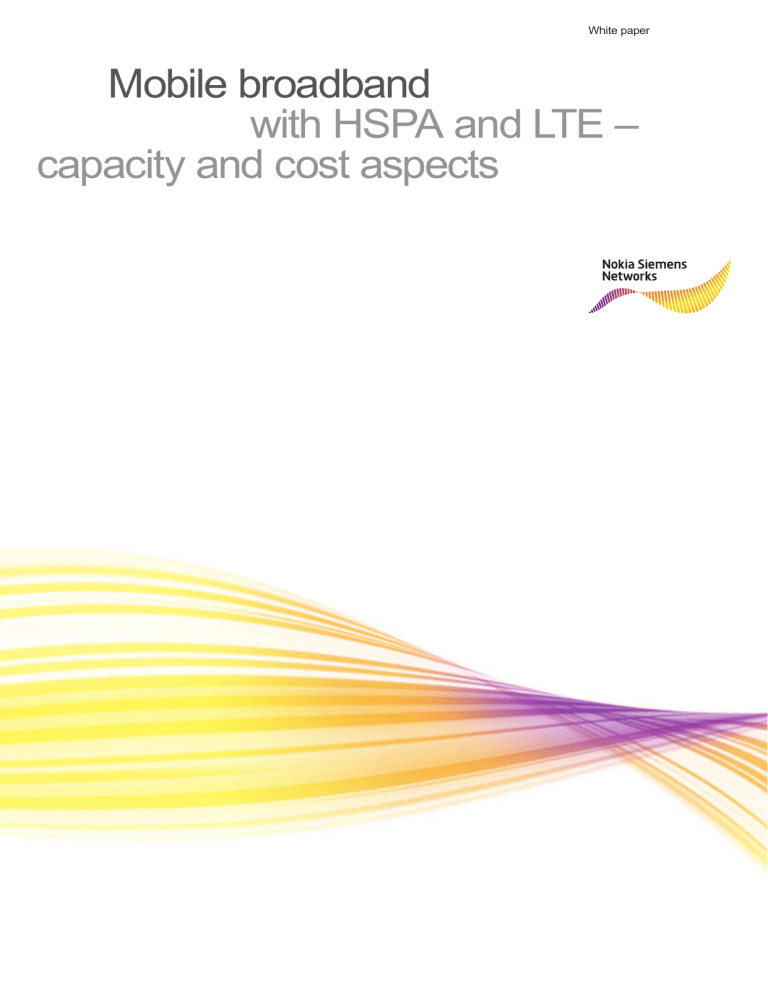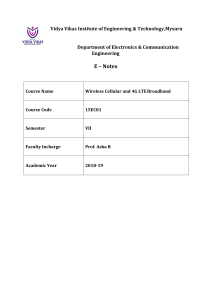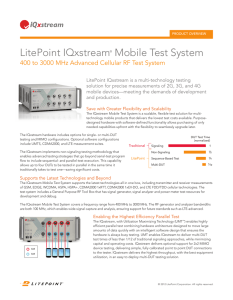
White paper Mobile broadband with HSPA and LTE – capacity and cost aspects Contents 3 Radio capacity of mobile broadband 7 The cost of mobile broadband capacity 10 Summary 11 Abbreviations The latest generation of smart devices and USB data modems for mobile computers has created explosive growth in network data traffic. In particular, mobile broadband via High Speed Packet Access (HSPA) has led to a significant rise in the number of subscribers and the amount of data they use. The volume of data traffic carried by cellular networks has already exceeded that of voice traffic. However, managing the ongoing growth of data traffic is a significant challenge for communications service providers (CSPs) who need to undertake careful planning of the network structure to achieve the performance that data services demand. This paper analyzes the maximum radio capacity of mobile broadband solutions from the viewpoint of traffic quality vs. traffic distribution over time and location. It suggests that user data rates can be improved by adding macro sites in hot spots, deploying six sector sites and implementing quality of service differentiation. Secondly, the paper gives a high level view of the cost of mobile broadband services, taking into consideration the volume of data traffic per user and the number of active data subscribers per site. The key finding is that monthly network Capital Expenditure (CAPEX) and Operational Expenditure (OPEX) can be kept below 3 EUR per subscriber over an eight-year depreciation period. This is true if the average mobile broadband penetration is at least 500 subscribers per site, and if subscribers use less than 2 GB per month. 2 Mobile broadband with HSPA and LTE – capacity and cost aspects Radio capacity of mobile broadband This section uses typical traffic distribution assumptions from live networks to estimate the maximum network capacity with HSPA and Long Term Evolution (LTE). The intention is to derive an approximate value for the maximum number of subscribers that can be supported by a specific base station site density with given spectrum resources. Figure 1 illustrates the estimation process. High Speed Downlink Packet Access (HSDPA) terminals send a Channel Quality Indication (CQI) to the base station every few milliseconds when they are sending or receiving data. The CQI indicates the maximum possible data rate that the terminal can receive with an error rate of less than 10%. CQI reports are used mainly for link adaptation and for packet scheduling algorithms, but they can also be used to estimate the maximum air interface capacity for network dimensioning. Traffic distribution between base station sites Maximum capacity per site from CQI values Traffic distribution over 24 hour period Usage per subscriber per month Total network level capacity in Terabytes per month Maximum number of subscribers Figure 1. Estimation of the maximum number of supported subscribers in the network % 20 % 100 18 Probability density 90 16 Cumulative density 80 14 70 12 60 10 50 8 40 6 30 4 20 2 10 Figure 2 shows an example CQI distribution over the whole network. For reference, CQI 15 corresponds to approximately 2.2 Mbps, CQI 20 to 4.9 Mbps and CQI 25 to 8.3 Mbps of HSDPA throughput. These throughputs assume that the cell is carrying only HSDPA traffic and no WCDMA Release 99 traffic. The median CQI value in Figure 2 is 21, which corresponds to 5.7 Mbps throughput. Figure 2. Example CQI distribution System level packet scheduling gains can increase cell throughput slightly, so in this example we assume 6 Mbps average cell throughput, which means 6 Mbps per 5 MHz carrier per sector in HSPA. The CQI values are affected by network planning, by the level of other-cell interference and by the performance of the terminal receivers. For LTE, we assume 35 Mbps cell throughput for 20 MHz bandwidth, which corresponds to 50% higher spectral efficiency than with HSPA. 0 1 3 5 7 9 11 13 15 17 CQI 19 21 23 25 27 29 0 Mobile broadband with HSPA and LTE – capacity and cost aspects 3 A margin in network dimensioning in the busy hour needs to be reserved in order to guarantee low delays and reasonably good data rates. In this example, a maximum 50% loading of the CQI values over the busy hour is assumed, which leads to an average busy hour throughput of 6 Mbps x 50% = 3 Mbps per cell in HSPA and 17.5 Mbps per cell in LTE 20 MHz. The 50% margin is not constant but depends on the targeted user data rates and on the applications. If background download applications are mainly being used, the busy hour loading could be more than 3 Mbps. Traffic is never equally distributed between sites. In a network, several sites will provide coverage, but will not be fully loaded. Figure 3 illustrates an example traffic distribution during the busy hour in which 50% of the traffic is carried by 15% of the cells. In estimating the maximum network capacity, this paper always assumes that it is those 15% of the cells that become congested and limit the total capacity. At the same time, 85% of cells are not congested. Network capacity could be improved by adding cell sites to the congested areas. The traffic distribution depends on the network deployment, country geography and number of users. Typically, more users lead to a more equal traffic distribution between sites. Share of traffic 50% 15% Share of cells Figure 3. Example traffic distribution between cells Share of daily traffic 7% 0:00 06:00 Figure 4. Example traffic distribution over a 24-hour period Traffic is also not equally distributed over a 24 hour period. The busy hour in data networks is typically in the evening, but data traffic is also generated during the night. Figure 4 shows an example traffic distribution in which the busy hour carries 7% of the network’s daily traffic. 4 12:00 Mobile broadband with HSPA and LTE – capacity and cost aspects 18:00 24:00 Figure 5 shows typical European spectrum resources. HSPA is deployed at 2100 and 900 while LTE is used at 2600, 1800 and 800. The total amount of spectrum is assumed to be 2 x 70 MHz paired spectrum per CSP. Now, let’s make an example capacity calculation with 10,000 and 20,000 base station sites, each with three sectors. Such a network would be typical of a large European country. It is assumed that each subscriber consumes an average of 5 GB of data per month in the downlink and uplink together, which is more than a typical user on an HSPA network today. The capacity is assumed to be downlink limited, while uplink use is assumed to be 30% of downlink use. This corresponds to 3.8 GB of downlink data and 1.2 GB of uplink data. For reference, typical voice use is 300 minutes per month, which corresponds to 36 MB of data in the downlink with 16 kbps equivalent data rate. Therefore, voice will be a minor Subs = Cell_capa[Mbps] 8192Mbit/GB 3.8GB/sub Spectrum Current 2600 (FDD 20 MHz) Future LTE 20 MHz 2100 (15 MHz) HSPA Multicarrier HSPA 1800 (15 MHz) GSM LTE 15 MHz 900 (10 MHz) GSM HSPA (5 MHz) + GSM (5 MHz) 800 (10 MHz) LTE 10 MHz Figure 5. Assumed spectrum resources part (1%) of the total traffic, but voice requires strict Quality of Service assurance to provide low delay and low error rate. The maximum number of subscribers is estimated by the following equation: 3(sectors) 3600s/hour 30days/month 50%(maxload) 7%(busy hour share) Sites 15% 50% (distribution) Mobile broadband with HSPA and LTE – capacity and cost aspects 5 Figure 6 shows the results. With 10,000 sites, the radio network can support up to 5 million data subscribers with HSPA and up to 22 million data subscribers with HSPA and LTE. With 20,000 sites, the capacities would be 10 million HSPA subscribers and 45 million with HSPA and LTE. Typically, existing networks with 10,000 sites have of the order of 20 million voice subscribers, while networks with 20,000 sites have 40 million subscribers. These calculations indicate that HSPA and LTE radio networks with typical spectrum allocation can provide 5 GB of data for all existing voice subscribers. Another way to calculate capacity is to consider user data rates. Let’s aim for a minimum of 1 Mbps user data rate. A so-called overbooking factor can be used to take into account the fact that only a small proportion of users will typically be downloading data at the same time. 3.8 GB of downlink data per month with 7% busy hour share corresponds to 20 kbps average data rate per subscriber during the busy hour, which is equal to an overbooking factor of 1 Mbps/20 kbps = 50. User expectations for data rates depend on the market, as well as the application and terminal being used. Markets with high wireline broadband penetration tend to have higher expectations for mobile broadband data rates, while users in markets with poor wireline broadband availability may be happy with lower data rates. Therefore, the dimensioning rules need to be adapted to market conditions. 6 Millions of subscribers 50 45 40 LTE HSPA 35 30 25 20 15 10 5 0 10000 sites 20000 sites Figure 6. Maximum number of broadband subscribers, each consuming 5 GB/month (using spectrum allocation from Figure 5) The following solutions can be used to provide even more capacity and to support more subscribers: • More macro sites could be added to congested areas. Nokia Siemens Networks Flexi base stations are compact, have zero-footprint and are fully deployable outdoors, which can make site acquisition simpler compared to conventional base station designs. • 6-sector sites offer typically 40–50% more capacity per site compared to 3-sector sites and up to 80% in the best case. (Source: “All-in-one mobile site solution boosts 2G, 3G and LTE network coverage and capacity”, Nokia Siemens Networks press release, November 4, 2009). Mobile broadband with HSPA and LTE – capacity and cost aspects • QoS differentiation can be applied to control the priority of heavy users when they exceed their monthly quota. Typically, a small percentage (less than 20%) of users takes most of the capacity (more than 80%). • Offloading traffic from the macro network to small cells like micro or femtocells (home NodeB/eNodeB). 3GPP Releases 8 and 9 include a number of enhancements for femtocells, including optimized architecture, as well as two-way handovers between macro and femtocells. 3GPP Release 10 includes the work item “Heterogeneous networks”, that provides enhanced interworking between macro cells and small cells. The cost of mobile broadband capacity This section estimates the cost of mobile broadband capacity and uses the following assumptions: • HSPA and LTE radios are considered with minimum configuration of HSPA 1+1+1 (5 MHz) and maximum configuration of HSPA 4+4+4 @ 900 (5 MHz) and 2100 (15 MHz), and LTE 3+3+3 @ 800 (10 MHz), 1800 (15 MHz) and 2600 (20 MHz). • The network CAPEX ranges from 40,000 to 400,000 EUR per site depending on the configuration. The minimum CAPEX corresponds to HSPA 1+1+1 configuration, while the maximum CAPEX corresponds to HSPA 4+4+4 and LTE 3+3+3 configurations. The CAPEX per site is assumed to be linear with the site capacity. • CAPEX depreciation occurs over 8 years. • The annual OPEX ranges from 8,000 to 80,000 EUR per site, depending on the configuration, including backhaul, site rental, power consumption and radio network software and hardware maintenance. The OPEX is clearly higher than CAPEX depreciation, and therefore, it is essential to minimize network OPEX. • We assume that 100% of OPEX is allocated for data but, in practice, part of the OPEX could also be allocated to voice traffic because the base station sites also provide the voice network. This would make the data cost lower than that shown in the calculations in this paper. • Site configuration is selected according to traffic requirements. Here, the same traffic distribution as in capacity calculations is assumed, in which 15% of the cells carry 50% of the traffic. Mobile broadband with HSPA and LTE – capacity and cost aspects 7 Figure 7 shows the cost per subscriber as a function of subscriber density per base station site. Figure 8 shows cost per gigabyte as a function of mobile broadband penetration. Subscriber density is the average value over the whole network. If the average number is, for example, 500 subscribers per site, there will be sites in the network supporting 1,000–2,000 subscribers, while many sites will provide mainly coverage for a few subscribers. Figure 8 assumes that there are, on average, 2,000 voice subscribers per site. The CAPEX + OPEX per subscriber are relatively high when the subscriber density is low. The cost reduces when there are more subscribers sharing the costs. With at least 500 subscribers per site each using less than 2 GB/month, the monthly CAPEX + OPEX will be below 3 EUR per subscriber. If the average data usage can be kept less than 2 GB and the subscriber density is very high, it is possible to push the monthly CAPEX + OPEX below 2 EUR. If the site rental and backhaul costs are partly allocated to voice, then the monthly CAPEX + OPEX for broadband data will be even lower. The cost of delivering a GB of data is highly dependent on the network utilization. If total data use is high, either due to a high number of subscribers or to high use per subscriber, the cost per GB can be below 1 EUR. Figure 8 shows that a cost of less than 1 EUR can be obtained with 40% mobile broadband penetration and 2 GB/sub/month. 8 EUR/sub/month 10 10 GB/sub/month 9 5 GB/sub/month 8 2 GB/sub/month 7 1 GB/sub/month 6 5 4 3 2 1 0 100 200 300 400 500 600 Average subs per site 700 800 900 1000 Figure 7. Network CAPEX + OPEX per sub per month EUR/GB 10 10 GB/sub/month 9 5 GB/sub/month 8 2 GB/sub/month 7 1 GB/sub/month 6 5 4 3 2 1 0 5% 10% 15% 20% 25% 30% 35% 40% Penetration of mobile broadband subscription Figure 8. Network CAPEX + OPEX per gigabyte of data Mobile broadband with HSPA and LTE – capacity and cost aspects 45% 50% A few notes on the cost calculations: • The most important factor in the cost calculations is network OPEX because it is typically higher than CAPEX. The largest contributors to OPEX are backhaul transport, site rental, network maintenance and electricity. Other OPEX factors, like customer acquisition and marketing, are not considered here. • It is essential to minimize OPEX by using efficient Ethernet transport, for example Ethernet based microwave radio, fiber or DSL, and by re-using existing base station sites. • The mobile broadband cost depends on how the site and transport costs are shared between voice and broadband data. • The relationship between cost and traffic per subscriber is not linear. If the traffic per subscriber grows ten-fold, the cost will increase only two- to three-fold. This is because the radio networks must always provide basic coverage even in low traffic areas. When the traffic increases, the low traffic areas do not need capacity upgrades. Furthermore, many cost elements in the high traffic areas remain similar or grow only moderately with traffic volumes. Such costs include site rental and backhauling costs. In other words, high data penetration and high data usage leads to lower cost per GB. Therefore, CSPs with a large market share will benefit from economies of scale. • LTE with new spectrum allocations is efficient for carrying higher traffic volumes. The benefit of LTE becomes clear when HSPA spectrum has already been fully utilized and further HSPA capacity would require new and costly base station sites. • Sufficiently high LTE terminal penetration is needed to offload traffic from HSPA to LTE. If LTE terminal penetration is low, it may be more cost effective to upgrade the capacity of the existing HSPA network than to deploy an LTE network. • Small femtocells can provide a significant capacity offload from the macro network, if marketed to users with appropriate use patterns. Macro cell traffic can also be offloaded to WLAN (WiFi) networks. Mobile broadband with HSPA and LTE – capacity and cost aspects 9 Summary The advent of smart devices and mobile computers has generated explosive growth of data traffic that challenges CSPs to make well-timed and focused investments. This paper shows that, with typical European spectrum resources, it is possible to provide up to 5 GB of data per month for every existing voice subscriber by using HSPA and LTE radios in existing sites. Radio capacity can be boosted further by deploying additional macrosites in hot spots, using 6-sector configurations, applying QoS differentiation, and by using micro- and femtocells in highly populated areas. Monthly network CAPEX + OPEX can be kept below 3 EUR per subscriber over an eight-year depreciation period if average mobile broadband penetration is at least 500 subscribers per site, and if data use is below 2 GB per subscriber per month. 500 subscribers correspond typically to 25% mobile broadband penetration. It is essential to re-use existing base station sites, and to deploy efficient Ethernet transport solutions using microwave radio or fiber. It is possible to provide up to 5 GB of data per month for every existing voice subscriber by using HSPA and LTE radios in existing sites. The cost of delivering a gigabyte of data per subscriber can be less than 1 EUR if total data use is high enough. LTE networks can lower the cost per bit, especially when HSPA spectrum is fully utilized, because adding LTE capability to existing sites costs much less than adding new HSPA sites. However, for this to be viable, sufficient LTE terminal penetration is needed to drive traffic onto the LTE network. This study provides an essential lesson: Increasing the subscriber base is vital for CSPs to achieve lower data delivery costs. This is because radio networks benefit from significant economies of scale, with high data penetration and high data use leading to lower cost per GB. The continued growth in smart device and mobile computer data traffic is creating a major disruption in the telecommunications industry that will require CSPs to accurately plan the timing and focus of their network investments. Monthly network CAPEX + OPEX can be kept below 3 EUR per subscriber over an eight-year depreciation period if average mobile broadband penetration is at least 500 subscribers per site, and if data use is below 2 GB per subscriber per month. 10 Mobile broadband with HSPA and LTE – capacity and cost aspects Abbreviations 3GPP CAPEX CQI CSP DSL CQI GB HSDPA HSPA LTE OPEX QoS WCDMA WLAN Third Generation Partnership Project Capital Expenditure Channel Quality Indication Communications Service Provider Digital Subscriber Line Channel Quality Information Gigabyte High Speed Downlink Packet Access High Speed Packet Access Long Term Evolution Operational Expenditure Quality of Service Wideband Code Division Multiple Access Wireless Local Area Network Mobile broadband with HSPA and LTE – capacity and cost aspects 11 Nokia Siemens Networks Corporation P.O. Box 1 FI-02022 NOKIA SIEMENS NETWORKS Finland Visiting address: Karaportti 3, ESPOO, Finland Switchboard +358 71 400 4000 Product code C401-00558-WP-201004-1-EN Indivisual Copyright © 2010 Nokia Siemens Networks. All rights reserved. A license is hereby granted to download and print a copy of this document for personal use only. No other license to any other intellectual property rights is granted herein. Unless expressly permitted herein, reproduction, transfer, distribution or storage of part or all of the contents in any form without the prior written permission of Nokia Siemens Networks is prohibited. The content of this document is provided “AS IS”, without warranties of any kind with regards its accuracy or reliability, and specifically excluding all implied warranties, for example of merchantability, fitness for purpose, title and non-infringement. In no event shall Nokia Siemens Networks be liable for any special, indirect or consequential damages, or any damages whatsoever resulting form loss of use, data or profits, arising out of or in connection with the use of the document. Nokia Siemens Networks reserves the right to revise the document or withdraw it at any time without prior notice. Nokia is a registered trademark of Nokia Corporation, Siemens is a registered trademark of Siemens AG. The wave logo is a trademark of Nokia Siemens Networks Oy. Other company and product names mentioned in this document may be trademarks of their respective owners, and they are mentioned for identification purposes only. www.nokiasiemensnetworks.com


